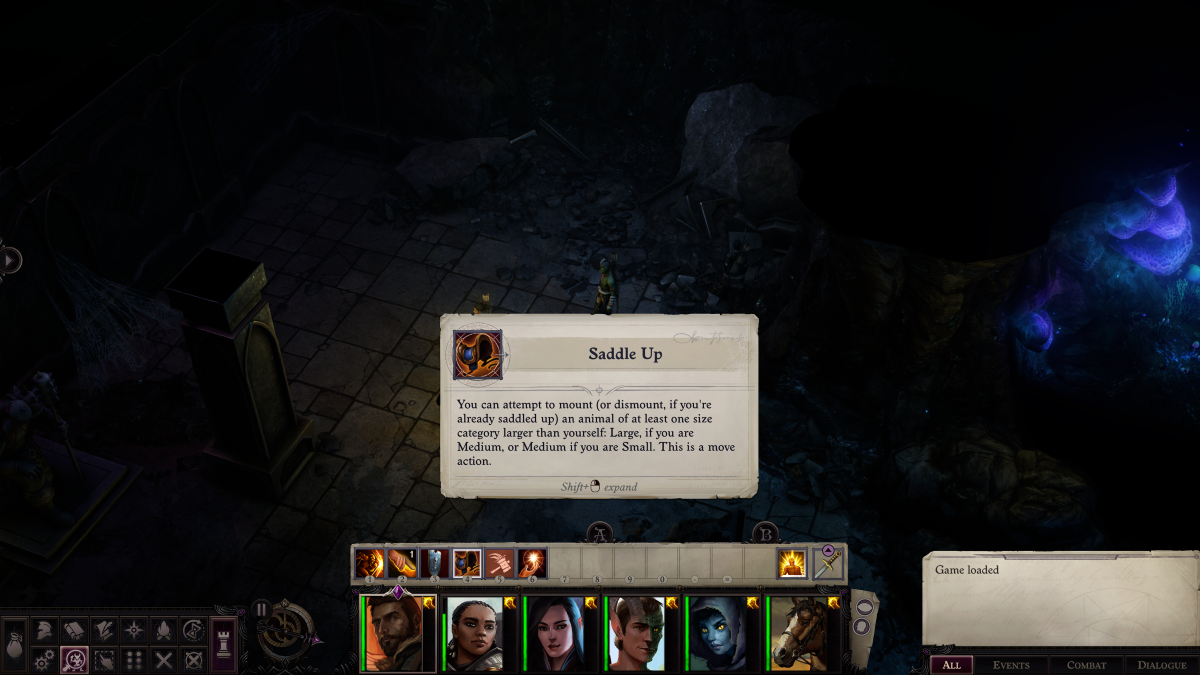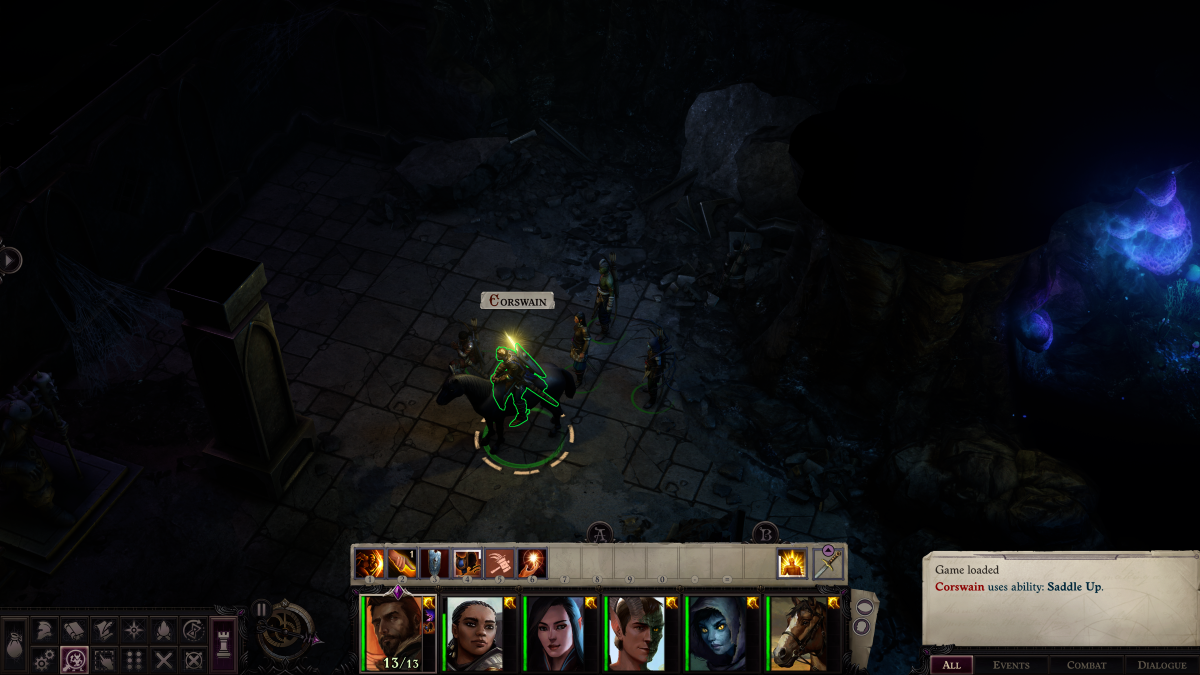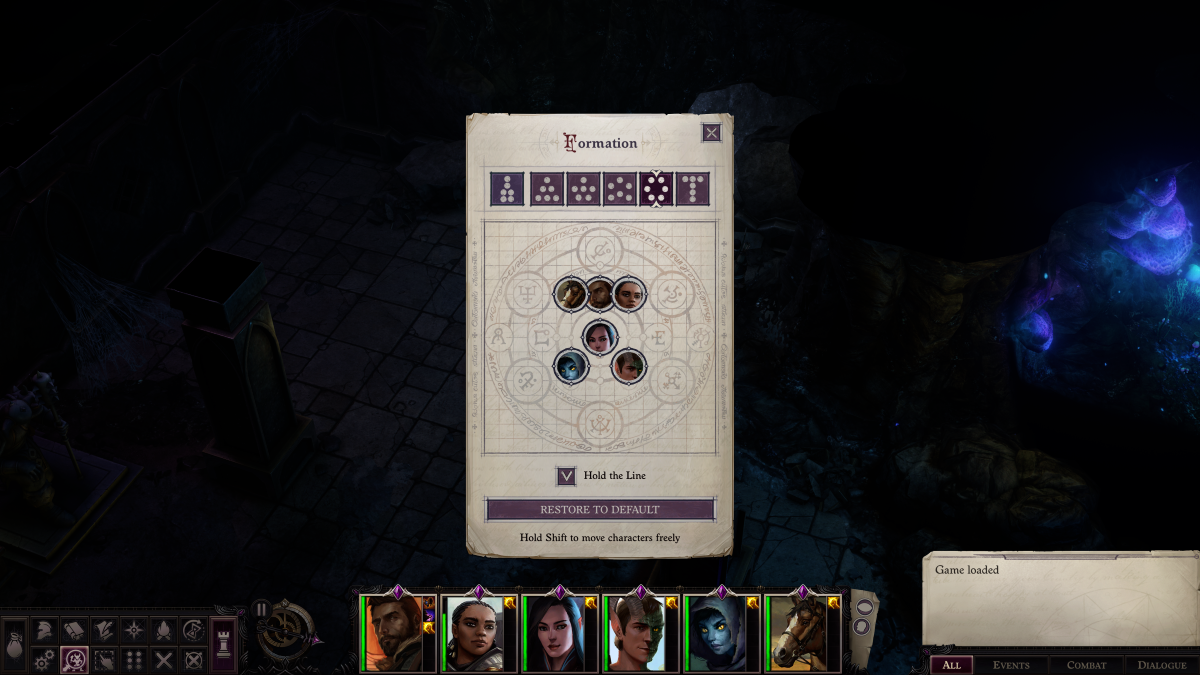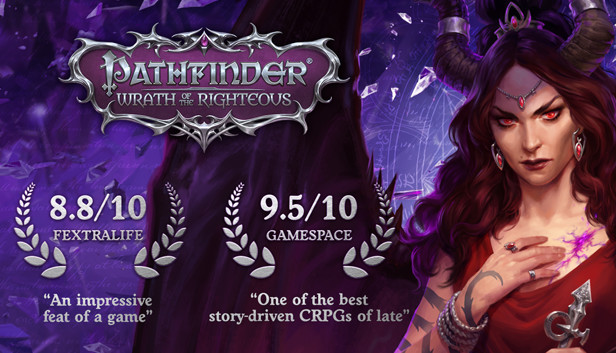The basics of how to do mounted combat effectively, since there is no other guide yet.
Introduction
This is based on my own experience playing a Cavalier (Gendarme) on a horse on normal difficulty. He is not so much a protagonist of an epic fantasy story as he is a Tomahawk cruise missile.
This is not an optimisation guide. This is not ‘the one correct way’. It’s just some information that may help you get more fun out of your gameplay.
Mounting your…Mount
mount.
- It is important that this is something you do regularly during and after combat, to monitor your mount’s health.
To mount your companion, it needs to be one size larger than you. For Halflings and Gnomes (small size), this means the companion must be at least medium size. For all other races, the companion must be at least large size. More on what this means for companion choices later.
To mount them, you need to use the “Saddle Up” ability. If you start at level 1 with a rideable-size mount, this ability will already be in your hotbar. If your companion only becomes rideable later, it will appear and be available under your abilities later.

Click on the ability, and then click on your companion, and your character will mount them. Clicking that ability again will deactivate it, causing your character to dismount.

- It should be apparent from this that it is important that your companion is right next to you in the party formation, so that you can mount and dismount quickly.

Saddle up is a move action. If you are not mounted at the beginning of combat, it will cost you your move action to mount.
- Therefore, if you are emphasising mounted combat, it is wise to be mounted at all times whenever possible, not just outdoors. Channel your inner Tywin Lannister.
A bug related to saddle up that I have commonly experienced is that if you click on a door, object or loot with your mounted character, or with the whole party selected but your character is the default closest to the object, the action will not complete. This mostly happens with inspection objects and containers, and rarely with doors and loot. It is obvious when this happens, you character freezes and is unable to accept new commands because it is stuck trying to complete the existing command.
- This is easily mitigated – dismount, and your character will dismount and complete the action. Then have your character saddle up again. It’s a few extra clicks but not that big a deal.
Riding your Mount
Pathing outside of combat is fine. Pathing in combat, particularly turn-based mode, can be bugged.
When selecting movement (the green and yellow dotted line), your character may get ‘caught’ on the edge of impassable terrain and end up losing their movement/turn, which is a bummer.
This happens when you instruct them to move in a bent line, because they do so by the shortest possible route and hug the edges.
- To mitigate this, in turn-based never click an instruction for a move in anything other than a straight line. When you need to move around something or turn, break it up into straight line segments, so you can clear the potential obstacle. In turn-based, you have plenty of time to plan it out.
Fighting atop your Mount
You and your mount occupy the same space, and are more or less the same entity for the purposes of combat. Even if your mount is large, you’re occupying a space no larger than two medium-size creatures standing side-by-side. This means a few things:
- You and your mount go at the same time in the initiative order, and concentrate your attacks at the same time, allowing you to focus-damage down enemies efficiently.
- You have the advantage of your mount’s speed, making you much more mobile to be where you need to be. This is really helpful in some situations, like or to head off an attack on the rear of your party.
- When you charge, both you and your mount get the bonus effects of charging. And you can charge pretty much anything you have a straight line to, because of your mount’s high movement.
- If you and your mount both have a teamwork feat, you always count as adjacent when you are riding. Precise Strike and Outflank are no-brainers – +4 attack and +1d6 damage on every attack? Yes please!
The bonuses to charging generally outweigh the negatives, and for cavaliers the negatives disappear.
- If you want to maximise melee mounted effectiveness, charge whenever possible to do so without receiving attacks of opportunity.
There are also a number of defensive effects, and some implications.
When you and your mount are attacked conventionally i.e. melee/ranged, it is your mount that is the target. It’s AC is used, and its hit points take the damage.
(NOTE: Area effect spells and damage – fireballs, alchemist’s bombs – will affect both you and your mount. Your mount will not take it all.)
- Therefore, your mount is something of a damage shield before you take damage.
However, if your mount dies, it will drop and you will fall prone in the same space. This is very bad if you have enemies in melee range, because:
- While prone you are easier to hit, and
- When it is your turn you will have to spend a move action standing up before you can do anything else, and every enemy in melee range will get an attack of opportunity on you as you do that.
So your mount going down underneath you in melee combat is very bad.
- Therefore, it is important to make class, progression and feat choices that maximise our mount’s survivability, if we intend to ride them in melee combat. That includes hit points, AC, saving throws and feats/abilities.
Miscellaneous Combat Tips
This does not seem to be the case with charging – on a charge you will always close nose-to-nose even if you have a reach weapon, so both you and your mount will get attacks.
- Therefore, if we want our mount to get attacks when not charging, do not use a reach weapons (or switch them out), use non-reach single or 2-handed weapons.
Much of being effective on a mount above and beyond what you can do on foot relies on planned positioning. Turn-based mode helps a lot with this. In Turn-based you are also much more likely to be able to set up multiple charges, whereas in RTWP you will usually only get 1 at the start of combat. Yes it is slower mechanically, but if you can get off multiple charges you will also end the combat quicker. A cavalier-gendarme on a horse with the spirited charge feat can charge one-shot enemies pretty reliably at level 3.
- Therefore, turn-based combat mode enables us to maximise the advantages of mounted combat.
I do not know if this is a bug or not, but currently much, if not all, of the time if you use your attack action for the ‘second move’ to get you into melee range, your mount can still make an attack even though you can’t. Which is nice.
Mount Selection
- If you want your character to specialise in mounted melee combat, the horse is a fine choice. They are fast, tough, and you can ride them from level 1.
Your animal companion will also have a ‘class’ choice. The most useful choice here is one that reinforces the play style and mount use you have decided for your character. If you intend melee mounted combat, bear in mind how important it is for your mount to not go down underneath you.
- Bulwark is a fine choice for a melee mount. Barding and damage resistance make the mount much tougher, and thus less likely to go down and leave you prone in a bad position.
For some feats, particularly teamwork feats, your mount needs an intelligence of 3 to qualify.
- Use your mount’s stat bonus increase at level 4 to raise your mount’s Intelligence, to unlock many useful teamwork feat options.
Feat Choices
- The Mounted Combat feat unlocks the full potential of melee mounted combat. Investing in Mobility will make your mount more survivable.
Why? Because it unlocks the ability to purchase the Spirited Charge feat. And this, THIS, is the true power of mounted combat. This feat doubles your damage on the charge. Not only your weapon damage dice, or bonuses, or energy effects, or sneak attack dice, or other bonuses. Everything doubles. Let the bodies hit the floor.
- The Spirited Charge feat is the big gun of melee-mounted combat.
The Indomitable Mount feat allows you to use a Mobility check to cancel your mount failing a saving throw, in the same way that Mounted Combat can mitigate a hit. If you have already invested in ranks in Mobility, this feat is worthwhile to further prevent your mount from going down under you.
- The Indomitable Mount feat makes your melee mount even more survivable.
The Trample feat is an interesting option, but less useful than it first seems. It is an action instead of attacking, not in addition to attacks. A charge is always better, and a full attack is usually better. It does potentially knock the enemy prone, which could be useful in some circumstances to create space, or give another party member a chance to retreat without incurring an attack of opportunity.
- Trample is not terrible, but less useful than other mounted combat feats
Teamwork feats, particularly Precise Strike and Outflank, are powerful options for you and your mount to take, because since you are occupying the same space, you will always meet the condition of being next to an ally with the same feat.
- As mentioned above, teamwork feats between you and your mount will always be ‘on’, and provide powerful bonuses. Therefore make sure you raise your mount’s intelligence to 3 so that they qualify for them.
Conclusion
I hope these basic principles and observations are useful to you and give you a little bit better understanding of mounted combat in Wrath of the Righteous, and make your game even more enjoyable.
Thanks to PradaMeinhof for his great guide, all credit to his effort. you can also read the original guide from Steam Community. enjoy the game.
Related Posts:
- Pathfinder Wrath of the Righteous: All Restored Crusader Relics Guide
- Pathfinder Wrath of the Righteous: In-game Char Builder (How to Plan Character)
- Pathfinder Wrath of the Righteous: Sacred Lands Puzzle Guide
- Pathfinder Wrath of the Righteous: Aeon Path (Code of Drezen)
- Pathfinder Wrath of the Righteous: “Core of the Riddle” Solution

